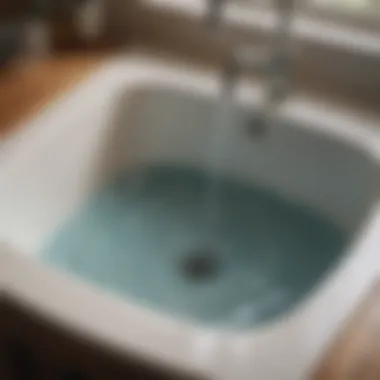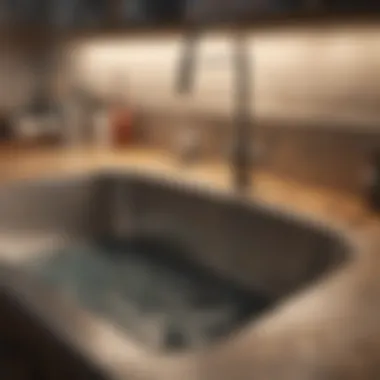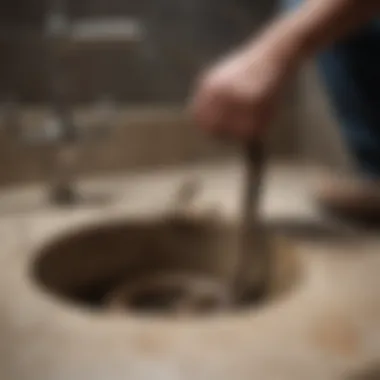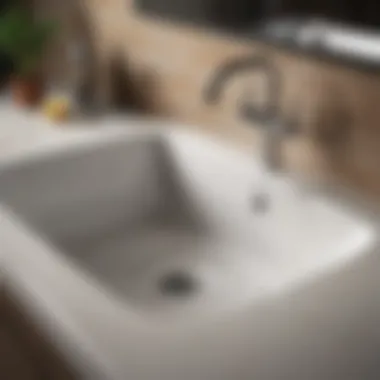Effective Solutions for a Slow Draining Sink


Intro
A slow-draining sink can be a real nuisance. It not only disrupts your daily routines but also hints at bigger plumbing problems. Imagine washing your hands, only to find water pooling around the basin. This common issue can stem from various causes, and pinpointing the right one can save homeowners from unnecessary headaches.
In this guide, we will delve deep into the reasons behind a sluggish sink and present tailored solutions that cater to both DIY enthusiasts and those who prefer professional help. From simple fixes using household items to knowing when it’s best to call in the experts, our aim is to empower you with the information you need for maintaining a seamless sink experience.
Understanding the Causes
When faced with the problem of a slow-draining sink, the first step is figuring out what’s causing the issue. Below are some typical culprits:
- Hair and Soap Scum: Over time, hair can weave itself into a tangled mess within the drain, combining with soap residue to form a solid blockage.
- Food Particles: In kitchen sinks, bits of food can get washed down and create clogs. This is especially common with greasy substances.
- Mineral Buildup: Hard water deposits can accumulate in pipes, narrowing the passage for water.
- Tree Roots: In some cases, tree roots can intrude into older sewer lines, causing serious drainage problems.
"An ounce of prevention is worth a pound of cure. Regular maintenance can save you time and effort in the long run."
DIY Fixes
Before reaching for expensive plumbing services, consider trying these do-it-yourself solutions to remedy a slow-draining sink:
- Boiling Water: Pouring boiling water down the drain can help dissolve minor clogs from grease or soap scum. It’s simple yet effective. Repeat a few times for stubborn areas.
- Baking Soda and Vinegar: This classic combination can create a foaming action that helps break down blockages. Start by pouring half a cup of baking soda into the drain, followed by half a cup of vinegar. Cover the drain for 30 minutes, then flush with hot water.
- Plumbing Snake: A plumbing snake can reach deeper clogs. Insert it into the drain and turn the handle, pushing through blockages until water flows freely again.
- Wet/Dry Vacuum: If your vacuum has a wet function, it can be a lifesaver. Set it to suck out the obstruction if accessible.
When to Call a Professional
Sometimes, all the do-it-yourself techniques in the world won't do the trick, and that’s when you need to pick up the phone:
- Severe Backups: If water is backing up in multiple drains, you might be facing a main line issue. Immediate intervention is crucial.
- Recurrent Problems: If you've noticed the issue returning despite efforts, there might be a larger underlying cause.
- Unpleasant Odors: Foul smells can indicate decaying material in the pipes—time to let a pro take a look.
In these scenarios, a licensed plumber can assess the issue with expertise that goes beyond typical DIY fixes.
Preventative Maintenance
Understanding how to maintain your sink can be just as crucial as knowing how to fix it. Here are several strategies to keep your sink draining smoothly:
- Regular Cleaning: Set a reminder to clean your sink and drains at least once a month. This simple task can greatly reduce the chance of clogs.
- Install Drain Screens: Using a screen can catch hair and debris before they slip into the pipes. It’s a preventative step that makes a world of difference.
- Watch What Goes Down: Be mindful of what you rinse down the sink. Avoid pouring oil or greasy substances and always scrape food scraps into the trash.
By being proactive, you can avoid the stress and disruption caused by a slow-draining sink and ensure that your home remains a comfortable refuge.
Foreword to Sink Drain Issues
Having a slow draining sink can be quite a nuisance, turning daily tasks into frustrating experiences. Addressing this problem is more than just a matter of convenience; it speaks to the broader health of your plumbing system and the overall functionality of your home. A slow drain often serves as a warning sign, hinting at underlying issues that could escalate if left untreated. Understanding these issues and their implications is crucial for homeowners and design enthusiasts alike.
Understanding Slow Drainage
Slow drainage occurs when water does not empty from a sink fast enough, leading to puddles filling up while you wash your hands or do dishes. It's a common issue that many people often overlook until it becomes urgent. Several factors contribute to slow drainage, including buildup inside the pipes or foreign objects lodged in drains. For instance, hair, soap residue, and grease can form clogs at the least expected times. Not only do these culprits hinder immediate functionality, but they can also lead to permanent damage if neglected.
Importance of Addressing the Problem
Delaying action on a slow drain can snowball into larger problems, from unpleasant odors to costly plumbing repairs. Ignoring even the most minor drainage issues could mean spending a fortune later on pipe replacements or extensive cleaning. Therefore, it’s essential to tackle the problem head-on.
"An ounce of prevention is worth a pound of cure."
This popular saying holds true in plumbing matters. By maintaining your sinks and addressing issues promptly, you can avoid the domino effect of plumbing issues that can arise from inaction. Not only does this save you money, but you also enhance your living space's aesthetic and functional appeal.


In summary, understanding and addressing slow draining sinks will not just keep your home running smoothly; it will also bring peace of mind. Whether you are a homeowner wanting to maintain worth and utility or a design aficionado looking to keep spaces visually appealing, grasping the fundamentals of sink drainage can prove invaluable.
Common Causes of Slow Draining Sinks
Understanding what causes a sink to drain slowly is crucial, as it lays the foundation for effective intervention. Unlike other household nuisances, a slow-draining sink might seem minor at first glance, yet it can escalate to a much larger problem if left unchecked. Addressing the common causes not only helps maintain smooth functionality but also prevents extensive future repairs that might arise from neglect.
Hair and Debris Buildup
One of the leading culprits behind low draining sinks is the accumulation of hair and various debris. Over time, strands of hair combine with soap residue, food bits, and other particles to form stubborn clogs. It’s often easy to overlook how much hair can collect, especially in the bathroom sink, where longer locks may easily fall.
Regularly cleaning the sink and drains is a must. Noting when hair strands go down the drain can help catch potential buildups early. You can use a pair of gloves to remove visible debris, or employ a hair catcher to prevent this from happening altogether. And let’s be honest, no one wants to find those nasty clogs waiting to greet them!
Soap Scum Accumulation
Soap scum may not be the most aesthetically pleasing topic, but it’s significant when it comes to a sink’s drainage efficiency. When soap mixes with hard water minerals, it creates a waxy buildup that can quickly clog pipes. This accumulation can be especially problematic in kitchens and bathrooms, where soap is used much more frequently.
To tackle soap scum effectively, it’s advisable to incorporate routine cleaning with some vinegar or specialized cleaners designed for such tasks. Just wiping the sink down regularly can prevent soap scum from blocking water flow and keep things running smooth.
Grease and Food Particles
If you’ve ever cooked a meal, you’re likely aware of the greasy aftermath that can linger after a cooking spree. Grease and small food particles that go down the kitchen sink can solidify over time, leading to significant blockages. If left unaddressed, what might start as a slow drain can turn into a full-blown clog that requires immediate attention.
Making it a habit to scrape plates clean before rinsing and avoiding pouring fats and oils down the sink can help manage this problem. You can also incorporate grease-cutting agents to clear minor buildups if you notice less-than-stellar drainage afterward.
Clogged P-trap
The P-trap, an integral part of your sink’s plumbing, is designed to hold a small amount of water to prevent sewer gases from rising through the drain. While it serves such a purpose, it can often become clogged with materials like hair, soap, and food debris. A clogged P-trap can significantly slow your sink’s drainage or even cause it to back up completely.
To check for issues with this part of the plumbing, it’s advisable to look under the sink for visible clogs. Many times, removing and cleaning the P-trap can solve the problem quickly. Ensuring that it remains clear is essential for both functionality and hygiene.
Tree Root Intrusion in Pipes
A daunting yet often overlooked element contributing to slow draining sinks is tree root intrusion. If you reside in an older home or one with significant landscape vegetation, it’s possible that tree roots have made their way into the underground pipes, leading to serious blockages. Roots seek moisture, and a cracked pipe can provide a perfect point of entry for them.
Identifying this issue typically requires professional assistance or specialized equipment. If you suspect this might be the case, it’s prudent to consult with plumbing experts who can assess your situation accurately. Ignoring tree root intrusion can lead to extensive damage and costly repairs down the line.
Preliminary Steps to Diagnose the Drainage Issue
Addressing a slow draining sink requires a thoughtful approach. Before diving into solutions, it’s crucial to diagnose the issue correctly. Skipping preliminary steps may lead to wasted efforts or even exacerbate the problem. Understanding the core of the issue can save time and money, helping you make informed decisions about potential fixes.
The first step in any scenario is to take a good, hard look at the problem before getting your hands dirty. This stage is vital because it lays a foundation for successfully resolving the slow drainage issue.
Visual Inspection of the Sink
When you notice slow drainage, a visual inspection is often the best first step. Look for obvious signs of trouble. Check if the sink is draining slower than usual and see if there’s any water pooling around the edges. Sometimes a quick look can reveal more than you expect.
Pay attention to:
- Foreign objects: Things like rings, soap, or even food debris can block the water flow.
- Stains or discolorations: These might indicate where the buildup of grime or soap scum is occurring.
- Unusual odors: If the sink has a funky smell, it usually means there’s something stuck in there that should not be.
A thorough inspection will help you understand the nature of the problem better and give you clues on how to tackle it.
Utilizing Basic Tools


Equipped with a little know-how and a few basic tools, many homeowners can deal with slow draining sinks without forking out a small fortune for a plumber. Two common tools stand out in this quest: the plunger and drain snake. Each serves its own unique purpose and knowing when to use them can be a game changer.
Plunger
The plunger is often the first tool in the arsenal against clogs and is well-regarded for its simplicity. The straightforward operation of a plunger can be its best characteristic, making it a favorite among DIY enthusiasts. It works by creating suction that dislodges blockages in pipes.
- Benefits: It’s inexpensive and can be found in almost every household. Plus, it requires no special skills to use.
- Unique Feature: The rubber cup at the end creates a powerful vacuum that pushes and pulls on stubborn clogs.
- Considerations: However, it can be less effective for deeper clogs that lie further down the pipes, often requiring more advanced tools.
Drain Snake
For deeper or more stubborn blockages, a drain snake might be just the ticket. This tool is designed to reach into the plumbing and clear clogs that are otherwise out of reach. Its flexibility allows it to navigate bends and turns in the piping system.
- Benefits: It can reach clogs that a plunger cannot and is generally very effective.
- Unique Feature: With its coiled design, it can grab onto debris and pull it out instead of just pushing it further down the line.
- Considerations: However, using a drain snake requires a bit more finesse. If not handled properly, it can cause damage to pipes or even contribute to further blockage.
Utilizing these tools effectively sets the stage for clearing out a slow-draining sink, paving the way for more extensive methods if needed.
Home Remedies for Clearing a Slow Draining Sink
When it comes to dealing with a slow draining sink, home remedies can often be the first line of defense. These methods are not only easy on the wallet but also environmentally friendly. In many cases, simple adjustments using items found in your kitchen can save you from costly plumbing bills or a professional visit. Additionally, relying on DIY methods fosters a sense of empowerment, enabling homeowners to tackle minor plumbing challenges with confidence. By understanding these remedies, homeowners can maintain a smoother, more efficient sink system without the usual hassle.
Baking Soda and Vinegar Method
The baking soda and vinegar method is almost legendary in DIY circles. It’s often touted as a natural remedy that can clear blockages while being safe for most plumbing systems. When combined, these two ingredients create a fizzy reaction, which can help dislodge debris stuck in the pipes.
To execute this method, start by measuring about half a cup of baking soda. Pour it directly into the drain. Following that, take half a cup of white vinegar and pour it right afterwards. You'll likely notice bubbling, which is a good sign! Allow this concoction to work its magic for about 30 minutes before flushing the drain with hot water. This can help clear out minor buildups efficiently.
"The beauty of this method lies in its simplicity and effectiveness—often, it works miracles, shining a light on just how effective household products can be."
Hot Water Pouring Technique
Pouring hot water down your sink is perhaps one of the easiest remedies available. While it may seem rudimentary, it often gets the job done, particularly in situations where grease or soap residue is clogging the pipes. Heat helps to dissolve the substances that may be causing the blockage.
To try this method, boil a pot of water on the stove. Once the water reaches a rolling boil, carefully and slowly pour it directly down the drain. It's advisable to do this in stages—pour a little and wait a moment before pouring more. This can gradually soften and wash away the gunky build-up that slows down the drainage.
Salt and Boiling Water Solution
If you have table salt in your pantry, you’re halfway to another effective remedy. The combination of salt and boiling water functions similarly to the hot water technique but adds the abrasive property of salt, making it more effective against stubborn clogs.
Begin by pouring about a half cup of salt into the drain, followed by a kettle of boiling water. The salt acts to break down build-up while the boiling water helps to wash it all away. This method is excellent for regular maintenance as it can prevent future clogs from forming, keeping your sink in tip-top shape well into the future.
Incorporating these home remedies into your regular cleaning routine can result in a significant reduction in sinking drainage issues. They not only extend the life of your plumbing but also promote a healthier home environment.
When to Seek Professional Help
When dealing with a slow draining sink, knowing when to wave the white flag and call in the experts can save you time, money, and a fair bit of hassle. While DIY fixes can work wonders in many cases, sometimes the situation can escalate beyond what a plunger or a bottle of vinegar can handle. It’s crucial to realize that some drainage problems require more experienced hands. Here, we’ll delve into the signs that indicate it's time to reach out to a plumbing professional.
Identifying Severe Clogs
An easy sign that your sink has a more serious problem is persistent clogging. If you’ve already tried several home remedies, and the sink remains as slow as molasses, you might have a blockage deep within the plumbing system. Some indicators of this include:
- Unusual sounds: Gurgling or bubbling noises while the sink drains can indicate air being trapped, which usually means something's stuck.
- Water backup: If water is continually pooling at the bottom of the sink, it might signal a severe blockage that can’t be cleared with a simple fix.
- Multiple drains affected: If you find that other sinks or even your bathtub are draining slowly as well, this points to a more extensive issue within your plumbing system, which may require professional intervention.


It’s important to observe these symptoms because leaving severe clogs untreated can lead to significant plumbing problems down the line.
Understanding the Risks of DIY Fixes
While pulling out a plunger or mixing up a concoction of baking soda and vinegar might seem harmless, it is essential to understand that some DIY approaches can actually cause more harm than good. Here’s a few pressing concerns regarding unsolicited fixes:
- Potential Damage: Overzealous attempts to clear clogs with metal tools can scratch or damage your pipes, leading to leaks.
- Chemical Exposure: If you resort to using strong chemical drain cleaners, you may encounter hazardous fumes that are unhealthy for both you and the environment. Such cleaners can even corrode your pipes over time.
- Time Sink: Rather than resolving the problem, your efforts may prolong the pain, making the clog worse and leading to costly repairs in the future.
Remember: When in doubt, bringing in a professional can be the best decision, as they can diagnose issues accurately and employ tools that most homeowners don’t usually have access to.
In summary, while DIY repairs can tackle simple problems with a slow draining sink, be mindful of the signs that indicate a more significant issue. Not every clog can be handled with a quick fix. When you find yourself repeatedly grappling with slow drainage or encountering associated problems in other parts of your home, it may be time to pick up the phone and call a trusted plumber.
Preventative Measures to Avoid Future Clogs
Taking steps to prevent your sink from draining slowly can save time, hassle, and possibly a significant repair bill down the road. Embracing preventative measures is not just about convenience; it's a proactive strategy that can prolong the lifespan of your plumbing system. A well-maintained sink contributes to a smooth-running household, allowing you to focus on your passions, whether that's cooking, cleaning, or simply enjoying a quiet space.
Regular Drain Cleaning Practices
One of the cornerstones to ensure your sink operates smoothly is implementing a routine cleaning schedule. Regular drain cleaning should not be an afterthought. By making it a habit, you minimize the accumulation of debris and buildup that can lead to slow drains. Set aside a few minutes each month to flush your drain with hot water. This simple step helps dissolve greasy residues that may gather over time.
Additionally, you might consider utilizing enzyme-based cleaners every few months. Unlike harsh chemical alternatives, enzyme cleaners work by breaking down organic matter, thus keeping your pipes healthy and clear.
"An ounce of prevention is worth a pound of cure."
Using Drain Screens
Investing in drain screens can prove to be one of your best defenses against clogs. These simple tools act as barriers, catching hair, food particles, and other debris before they have a chance to slip down the drain. It’s important to regularly clean the screens, removing any trapped material that could eventually lead to a blockage. It’s a small action, yet it delivers big results in terms of preventing slow drains.
Consider using screens with small mesh holes, as they effectively block out even the tiniest of particulates. They come in a variety of styles, so you can find one that suits your kitchen or bathroom's aesthetic.
Mindful Disposal of Waste
Lastly, the way you dispose of waste can significantly impact your sink's drainage. Mindful disposal of waste involves understanding what should and shouldn't be allowed down your sink. Some oils and fats may seem innocuous at first but can solidify in pipes over time, leading to troublesome clogs. Instead of pouring grease down the sink, let it solidify and dispose of it in the trash.
Similarly, avoid putting fibrous or starchy food scraps down your disposal. Items like potato skins and pasta can swell and latch onto other debris, contributing to drainage issues. Always keep a small compost bin or garbage bowl nearby to facilitate proper waste disposal.
By adopting these preventative measures—regular cleaning, using drain screens, and being mindful about waste—you can greatly reduce the likelihood of facing a slow-draining sink. This proactive approach not only saves you from frustration but also enhances your home’s plumbing longevity.
Closure
As we wrap up this discussion on tackling slow-draining sinks, it’s vital to recognize the significance of understanding and addressing this common household issue. A sink that drains sluggishly doesn’t just irritate; it can also lead to more serious plumbing problems down the line. Ignoring the signs can lead to bigger headaches, including foul odors, water pooling, or even potential water damage in your home. Thus, taking action sooner rather than later can save you time, effort, and potentially even money.
Recap of Solutions and Strategies
Throughout the article, we have examined various solutions that range from simple home remedies to more advanced techniques. Here’s a quick recap to solidify what you’ve learned:
- Preliminary Diagnosis: Start by visually inspecting the sink and using basic tools like a plunger or drain snake to gauge the severity of the blockage.
- Home Remedies: You can try methods like the combination of baking soda and vinegar, pouring hot water, or using salt with boiling water to tackle minor clogs effectively.
- Professional Help: When do-it-yourself remedies aren’t cutting it, understanding when to call in a professional can be key in preventing further complications.
- Preventative Measures: Regular maintenance practices, such as using drain screens and disposing of waste mindfully, can help keep your drains clear, reducing the likelihood of future slowdowns.
Overall, proactively caring for your sink not only enhances its functionality but also contributes to the longevity of your plumbing system.
Encouragement for Ongoing Home Maintenance
Home maintenance isn’t a one-time episode; it’s a continuous journey that requires regular attention and care. Just like any other aspect of our homes, sinks need some TLC too. Developing a routine for checking and cleansing your drains might not seem like a priority, but it can have a significant impact on your day-to-day life. Think of it as an investment in your home—one that pays dividends in convenience and peace of mind.
Furthermore, consider involving family or housemates in these maintenance tasks. Not only does it lighten the load but it creates a shared sense of responsibility for your living space. Remember, a well-maintained sink goes a long way toward promoting a harmonious home environment.
"An ounce of prevention is worth a pound of cure."
In summary, by following best practices and staying vigilant, you can prevent the pesky slow-draining sink from becoming a recurrent nuisance. Stay proactive, keep checking those drains, and enjoy a smoother plumbing experience!



